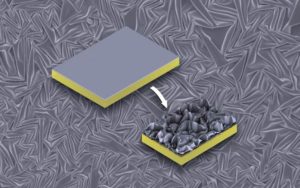 Nanotexturing polymeric surfaces changes their surface properties while their bulk properties remain unchanged. Wrinkles and folds can increase the efficiency and mechanical stability of optical and electrical devices. We have found a parallel method to create nanometer-scale textures over large areas with unprecedented control over wrinkle wavelength. Through reactive ion etching (RIE) we can create polymeric nanowrinkles on the surface of thermoplastic polystyrene (PS) substrates. This RIE treatment of PS is a new material system (skin and substrate) that can be used to vary the wrinkle wavelength from several microns down to as small as 30 nm simply by decreasing the exposure time in the RIE. We found that ellipsometry can measure the thickness of the modified layer. The thickness of the skin layer was used to (1) determine the Young’s moduli of the skin and substrate and (2) control wrinkle wavelength. Using RIE and ellipsometry, we were able to control the average wrinkle wavelength within ± 5 nm. We anticipate that our work will facilitate understanding of the mechanism underlying optical and electrical device enhancement and improve their performance.
Nanotexturing polymeric surfaces changes their surface properties while their bulk properties remain unchanged. Wrinkles and folds can increase the efficiency and mechanical stability of optical and electrical devices. We have found a parallel method to create nanometer-scale textures over large areas with unprecedented control over wrinkle wavelength. Through reactive ion etching (RIE) we can create polymeric nanowrinkles on the surface of thermoplastic polystyrene (PS) substrates. This RIE treatment of PS is a new material system (skin and substrate) that can be used to vary the wrinkle wavelength from several microns down to as small as 30 nm simply by decreasing the exposure time in the RIE. We found that ellipsometry can measure the thickness of the modified layer. The thickness of the skin layer was used to (1) determine the Young’s moduli of the skin and substrate and (2) control wrinkle wavelength. Using RIE and ellipsometry, we were able to control the average wrinkle wavelength within ± 5 nm. We anticipate that our work will facilitate understanding of the mechanism underlying optical and electrical device enhancement and improve their performance.
